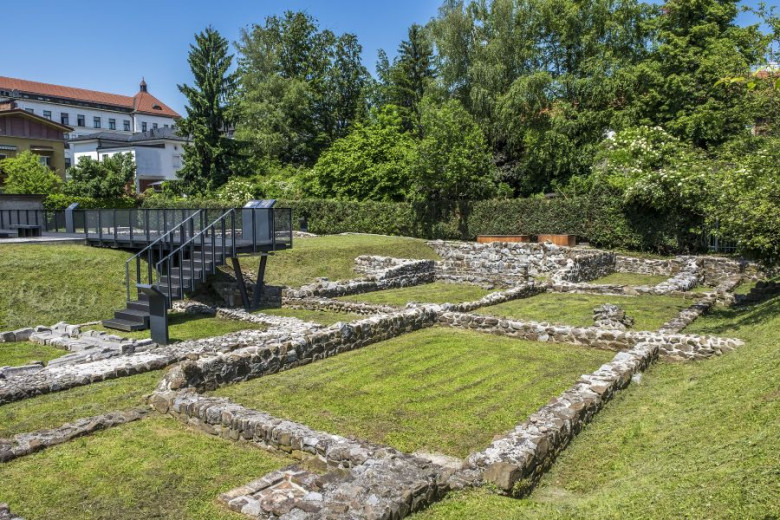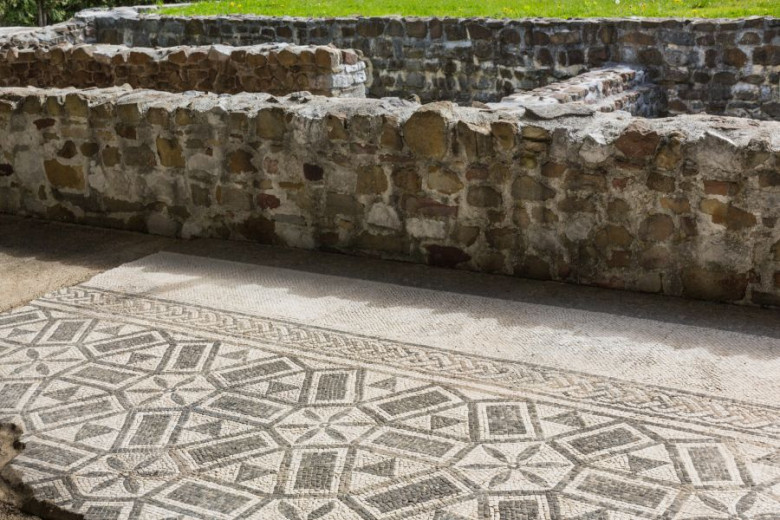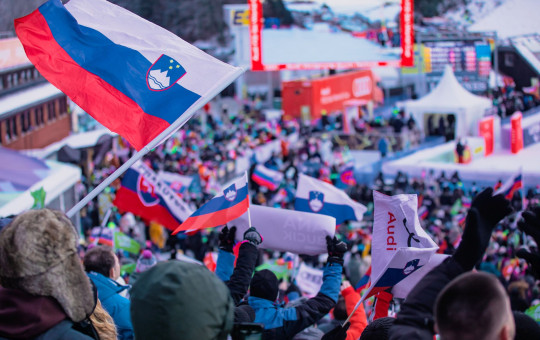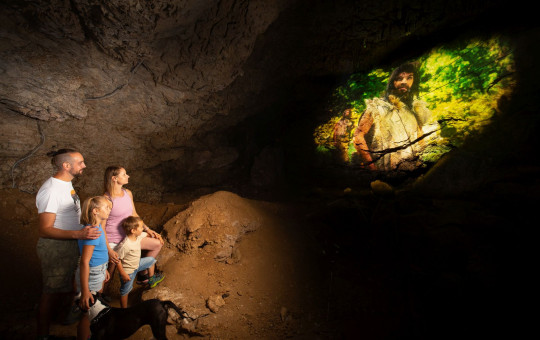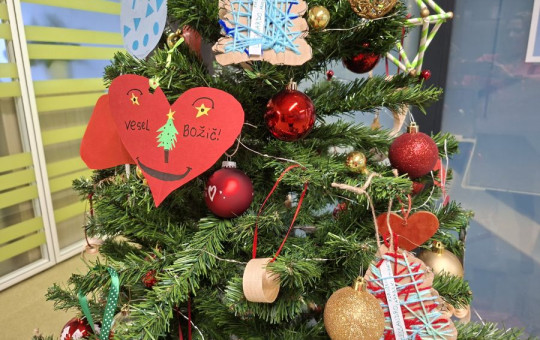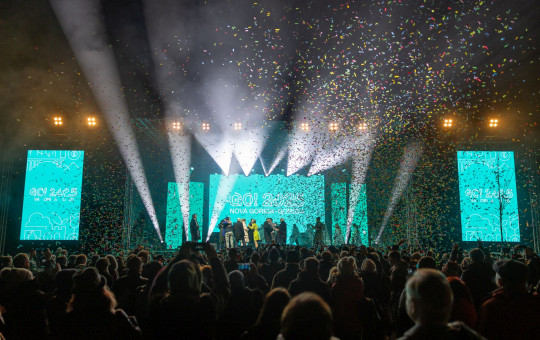Date: 10. September 2024
Time to read: 3 min
The Ljubljanica Basin has been inhabited since prehistoric times. Important trade routes connecting the Apennine Peninsula, the Baltic, and the Balkans already traversed the area during the pre-Roman period. Ljubljana holds numerous Roman treasures and stories, some of which we can sense, know, or are perhaps mistaken about.
Emona, the Roman city once located here, continues to inspire us even today. Although it existed long before the medieval and modern eras, it might have been superior in many ways. Fascinating finds of artifacts and building remains allow us to explore the streets of Emona, its way of life, values, and social interactions.
The city thrived from the 1st century until the early 6th century. Initially, the Romans came as traders but later arrived as enemies and conquered the area.
The Roman city measured approximately 523 by 435 meters. Even if one walked around the city wall, the route would be shorter than two kilometers. Archaeologists have uncovered parts of Emona, yet many stories about its people and daily life still lie beneath the surface. However, it is certain that Emona had almost everything one would find in larger Roman cities.
-
 Emona (Colonia Ivlia Aemona in Latin) was a Roman settlement in the centre of today's Ljubljana. Its name is probably of Celtic, pre-Roman origin. The area of Emona was at first under the jurisdiction of the Cisalpine Gaul province, while it later merged into Italy itself. Photo: Andrej Peunik
Emona (Colonia Ivlia Aemona in Latin) was a Roman settlement in the centre of today's Ljubljana. Its name is probably of Celtic, pre-Roman origin. The area of Emona was at first under the jurisdiction of the Cisalpine Gaul province, while it later merged into Italy itself. Photo: Andrej Peunik
-
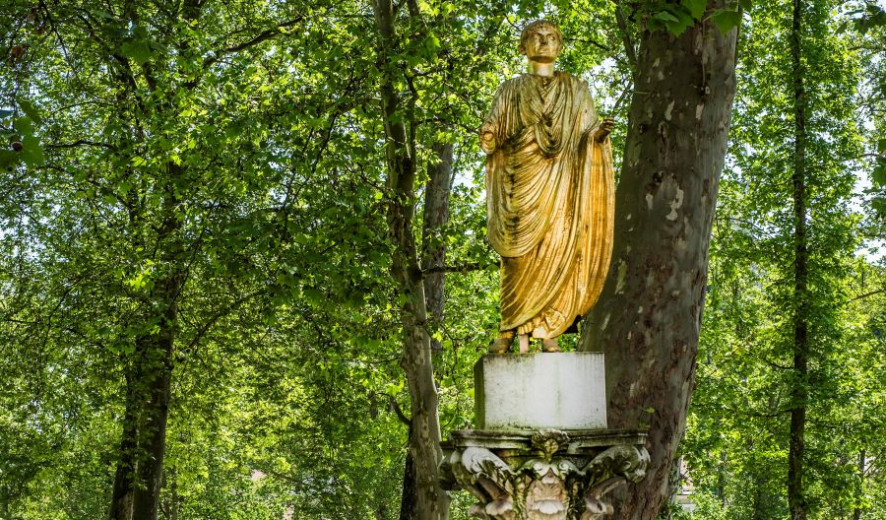 The Emona citizen is a 145 cm high statue of a young man, wearing a toga. Photo: Luca Baronchelli
The Emona citizen is a 145 cm high statue of a young man, wearing a toga. Photo: Luca Baronchelli
Divine Markers Defined the City’s Boundaries
Indeed, after the Year of the Birds, the Romans established Emona within divine coordinates. The construction of this beautiful Roman city took about three years, primarily built by Roman soldiers.
The city was populated by colonists mostly from northern Italy, along with agricultural estates and farming settlements, and, of course, slaves.
The streets were arranged in a grid of intersecting roads. Not all houses in the city were identical. Most were single-story structures with inner courtyards and were enclosed on the outside. The city walls were robust and high, ensuring protection from enemies. Emona's walls stretched from Cankarjev dom to Kongresni trg along Vegova Street and Emonska Street to Mirje, eventually reconnecting to the starting point.
A Vibrant City Life
Like other Roman cities, the heart of Emona was its central square—the forum. This bustling area featured a temple, a basilica (which served as a judicial and administrative building, and from the 4th century onwards, a church). Shops were located here where goods were bought and sold.
The forum was also the place to hear news, participate in legal proceedings, conduct business discussions, and celebrate various events. It likely also served as a venue for theatrical performances, in which only men performed.
Romans in the city also socialized at private parties, which were a testament to the host’s status. At some feasts, there was so much food that guests threw it onto the floor. Gluttony and excess were essential for the reputation of a prominent and wealthy Roman. Symbols of wealth included clothing, garment clasps, vessels, and, of course, lifestyle habits.
Spirituality and Religion in Emona
During the Roman era of polytheism, Emona, like other parts of the empire, honored the divine triad from the Roman Capitoline Hill: Jupiter, Juno, and Minerva. Additionally, other gods were worshiped, including.Laburusa and the Goddess Ekorno: The Dawn of Christianity in Emona
During the 4th century, Christianity had become a legal and permitted religion in Rome. Emona, too, witnessed this transformation, with a well-preserved baptistery where Romans were baptized in adulthood.
-
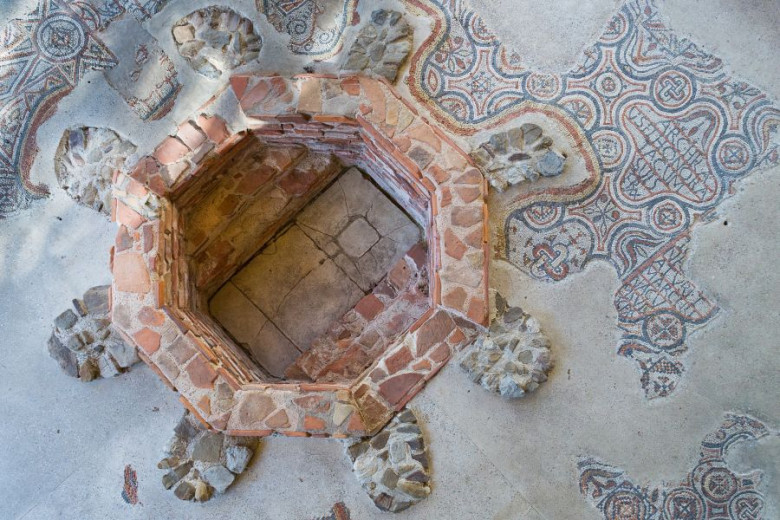 A place for baptism. Photo: MGML archive
A place for baptism. Photo: MGML archive
-
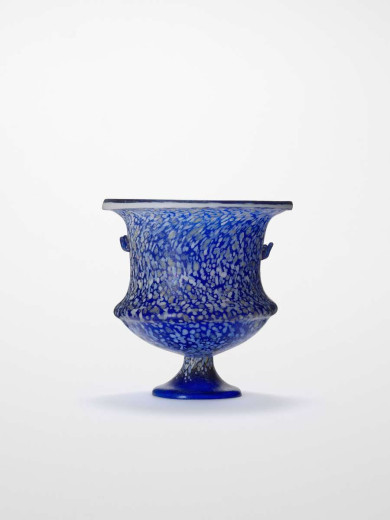 On the cemetery site in the northern part of Emona, archaeologists have discovered several glass vessels. These were intended for the deceased on their final journey to the afterlife (they contained food, perfumes, beverages, etc.). Photo: Andrej Peunik
On the cemetery site in the northern part of Emona, archaeologists have discovered several glass vessels. These were intended for the deceased on their final journey to the afterlife (they contained food, perfumes, beverages, etc.). Photo: Andrej Peunik
Its story shows that Emona has the important role
Emona held an important role in the defence of Italy between the 2nd and 4th century. During the 2nd century the city suffered due to Marcomannic Wars and plague, while in 238 its own citizens burned it down and abandoned it to prevent the army of the usurper Maximinus Thrax to make camp there. In 408 Emona was visited by Alaric I, king of the Visigoths. As the Byzantine magister militium he was on a mission to retake Italy for the Byzantine Empire and it is likely that bribes saved the skins of Emonans.
In 452 the city was ravaged and partially destroyed by the Huns. Emona was impoverished but lived on. At the end of the 5th and start of the 6th century the city was ruled by the Visigoths, who left only a few tracks behind. During the restless times of Late Antiquity and the Migration Period in the 6th century people started taking refuge in remote and inaccessible locations (Sveti Lovrenc on the Polhograjska gora hill, Molnik, Moreček, Golo) and migrating to coastal cities, especially Koper, Piran and Novigrad, until the last citizen left Emona.
-
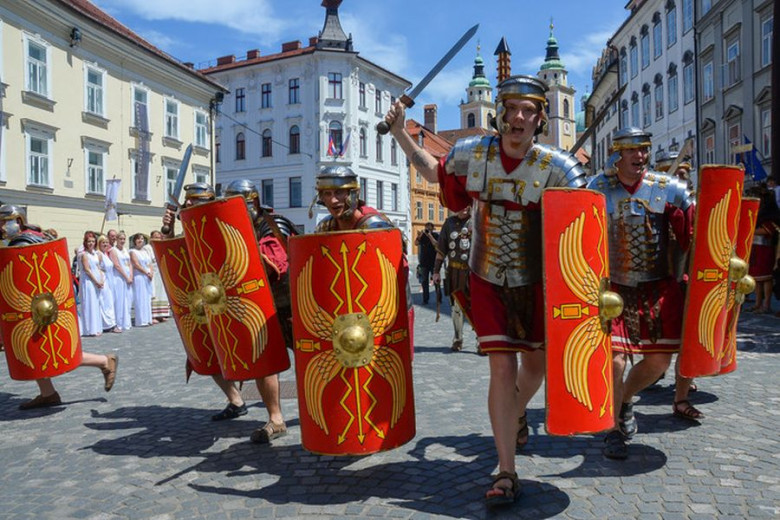 In 2014 Ljubljana celebrates 2000 years of the Roman City of Emona, situated on the site of today’s Slovenian capital. An inscription from 14 AD about a donation given to Emona by the emperors Augustus and Tiberius proves its existance. Emona was built on a Roman model and due to its geographical position it played an important role in the empire. Photo: Dunja Wedam
In 2014 Ljubljana celebrates 2000 years of the Roman City of Emona, situated on the site of today’s Slovenian capital. An inscription from 14 AD about a donation given to Emona by the emperors Augustus and Tiberius proves its existance. Emona was built on a Roman model and due to its geographical position it played an important role in the empire. Photo: Dunja Wedam
-
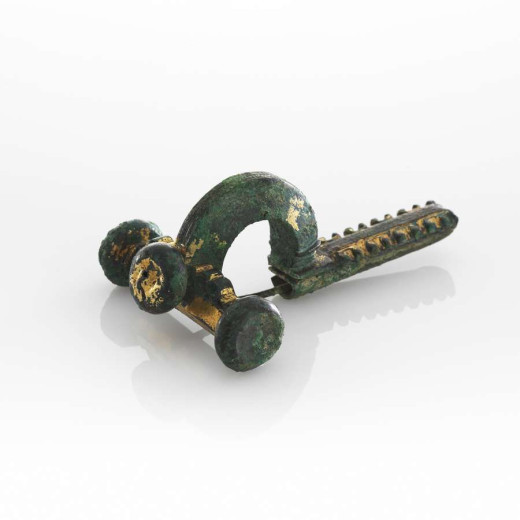 Both men and women in Emona would have worn brooches over the toga or long tunic. Photo: Blaž Gutman
Both men and women in Emona would have worn brooches over the toga or long tunic. Photo: Blaž Gutman
Jože Plečnik’s Modern Interpretation
The Roman walls of Emona were preserved in a new interpretation thanks to architect Jože Plečnik. He designed new entrances, added pyramids, erected columns, and constructed an arched lapidarium showcasing finds from nearby Emona houses. Plečnik also created a park around the walls, incorporating architectural elements from antiquity. On the Mirje side, he planted a line of poplars. Although this form has not fully survived, Plečnik's intervention brought Emona's ancient heritage into the public eye for the first time in Ljubljana. His work included new interpretations and elements of Roman architecture, filling the archaeological park with both original and modern pieces.
-
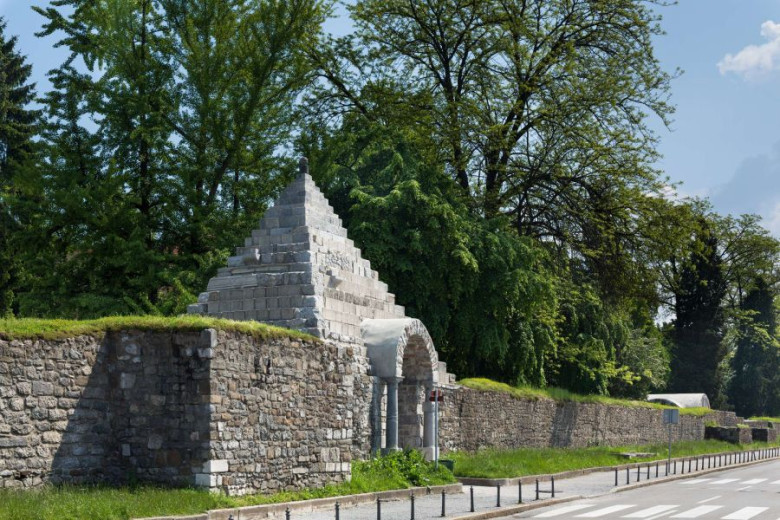 Roman wall in the Ljubljana district of Mirje was discovered by archaeologists in the first decade of the previous century. It later faced the threat of demolition, but was subsequently restored and interpreted according to Plečnik's plans. Photo: MGML archive
Roman wall in the Ljubljana district of Mirje was discovered by archaeologists in the first decade of the previous century. It later faced the threat of demolition, but was subsequently restored and interpreted according to Plečnik's plans. Photo: MGML archive
-
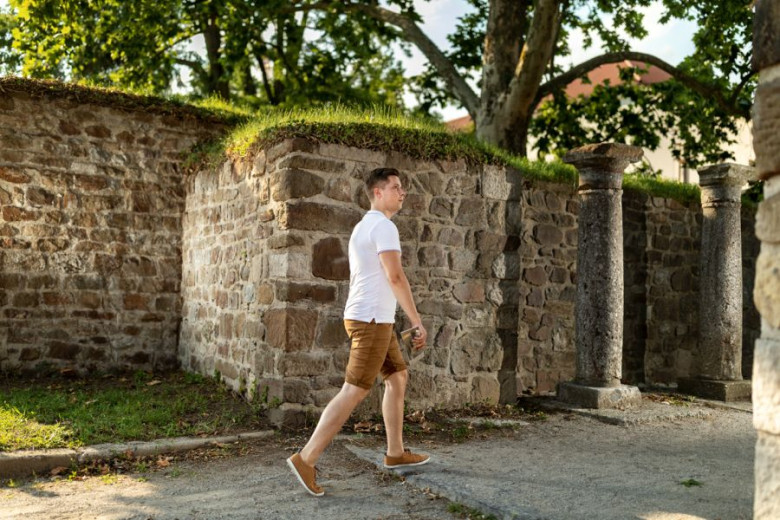 The wall shell was built from carved stone blocks bound with mortar and filled with a conglomerate of river pebbles, small rocks, sand and lime. The wall structure was so solid and robust that certain parts of the wall survived for as long as 2,000 years. Photo: MGML archive
The wall shell was built from carved stone blocks bound with mortar and filled with a conglomerate of river pebbles, small rocks, sand and lime. The wall structure was so solid and robust that certain parts of the wall survived for as long as 2,000 years. Photo: MGML archive
Welcome to a trail tracing the 2000-year-old heritage of Emona
Museum and Galleries of Ljubljana showcases a rich movable heritage and is dedicated to presenting contemporary domestic and international visual art. Immerse Yourself in History of Emona. Whether you are a history buff or a casual visitor, Emona's treasures provide a fascinating journey into the past.
Discover how this ancient city has shaped the modern landscape of Ljubljana and experience the enduring legacy of Roman civilization.
Discover the ancient town’s mysteries along a circular trail of Roman Ljubljana.
More: https://mgml.si/en/city-museum/exhibitions/263/archaeological-park-emona/

